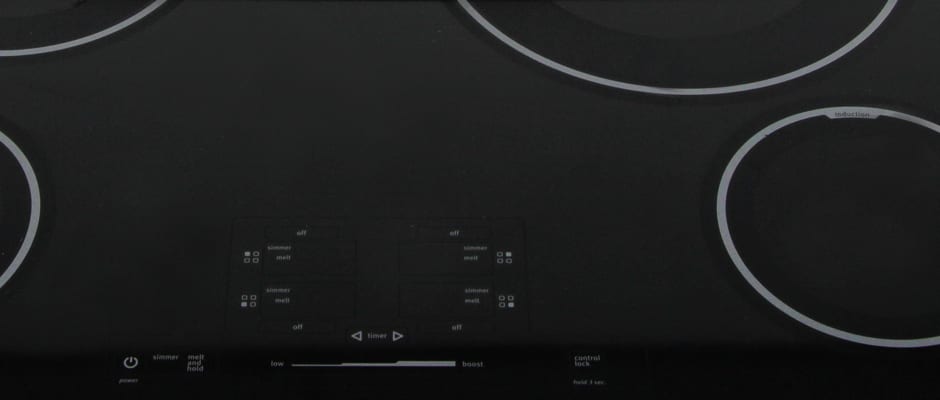Pros
Cons
Introduction
Design & Usability
{{section_header}}{{section.name}}{{/section_header}}
Slightly different from your garden-variety Maytag electric range.
Maytag's electric and induction ranges look pretty similar, save for one key difference in usability: the placement of the rangetop controls. Instead of putting the controls on the backsplash, Maytag has moved them to the front of the rangetop itself, similar to many European-made standalone induction cooktops. This is an excellent compromise between keeping them childproof (the advantage of rear controls) and keeping users from reaching over a hot stove (the advantage of front controls).
Besides the new control panel, the range looks like a standard midrange Maytag. The giant 6.2 cubic foot convection oven has a recessed "Max Capacity" rack, two standard racks, and a warming drawer below. Unlike gas, the smooth induction surface is easy to clean. And unlike electric, the lack of actual heating elements helps prevent burned-on deposits, and allows for near-immediate cleaning after cooking. Inside the oven, the Whirlpool Corporation's signature AquaLift water-based cleaning system is on offer.
{{photo_gallery "Vanity", "Front", "Rangetop Controls", "Oven Controls", "Burners 1", "Burners 2", "Burners Cleaning", "Upper Oven", "Upper Oven Detail", "Oven Detail", "Lower Oven Detail", "Lower Oven", "Drawer", "Broiler",}}
Rangetop
{{section_header}}{{section.name}}{{/section_header}}
Maytag's induction rangetop delivers a classic induction performance.
The irrepressible induction rangetop conquers our testing rubric once again with spectacular results. Astonishingly fast boiling times from all burners make this range appealing for pasta partisans, and the wide temperature range will please those chefs who need to go extra high or low to coax just the right flavors out of dishes. Also note that as an induction range, changes in heat take place almost instantaneously, with little of the lag present on a conventional electric range. The only downside of induction is that your cookware must be able to attract a magnet.
Oven, Broiler, & Convection
{{section_header}}{{section.name}}{{/section_header}}
Too much variance and not enough accuracy.
Aside from the brief 8.5 minute preheat and the powerful broiler, we found very little to celebrate. None of the oven's settings—keep-warm, 350°F (convection and conventional settings), 500°F—could keep a steady temperature. And with the exception of the maximum setting, the oven significantly overshot the temperature on the display panel. Most home chefs will just learn to adjust their recipes to deal with an inaccurate thermostat. But serious bakers will want to steer clear, as serious fluctuations in temperature (more than 20ºF either way at 350ºF) can leave food burnt on the outside or undercooked on the inside.
Conclusion
{{section_header}}{{section.name}}{{/section_header}}
An inexpensive induction rangetop with an unappealing oven.
The {{product.name}} made a noble attempt at bringing more induction options to the mid-level range price point, but with all the focus on spectacular induction rangetop performance, Maytag lost the plot when it came to the oven. The price alone is attractive enough to consider this range in spite of its flaws, but we'd recommend checking out the competition for a slightly more well-rounded option.
From the Lab
{{section_header}}{{section.name}}{{/section_header}}
We were really blown away by the {{product.nam}}'s rangetop, which delivered pro range performance in all our tests: the least-powerful burner boiled as fast as some other ranges' most-powerful. Unfortunately, the performance plummeted as we tested the oven. However, we did record one good test result in the oven: the broiler.
Oven Performance
{{section_header}}{{section.name}}{{/section_header}}
We expect something at least adequate for a $1,849 MSRP.
The {{product.name}} had problems with both temperature accuracy and fluctuation. The 350°F setting averaged 377°F, almost 30°F hotter than it was supposed to! Tossing the convection fan into the mix, we weren't much more impressed with the 365°F average we recorded.
We were happy to see the maximum setting of 500°F did hit its target, but then fluctuated up to 547°F. This fluctuation plagued the rest of the tests as well, and we found the oven operating in a 73°F and 66°F window at the 350°F and 350°F convection settings. Use the oven at your food's risk.
{{photo_gallery "Primary Oven Keep-Warm", "Primary Oven 350F", "Primary Oven Max", "Secondary Oven Convection", "Oven Variance"}}
Rangetop Performance
{{section_header}}{{section.name}}{{/section_header}}
The rangetop is the polar opposite of the oven.
Unlike the tragedy we found in the oven, there rangetop did everything right. Two burners boiled were powerful enough to boil six cups of water in under three minutes, which is quite the feat. The other two came in five minutes. If just two burners had hit the five minute mark, the range would have still received a decent score.
But despite the boiling power, we found the rangetop had no problems playing it cool. We recorded satisfactory temperatures just over 100°F on all but the rear left burner—temperatures suitable for gently melting butter or chocolate. The searing side of the temperature range were between 651°F-862°F on the boost setting—only one burner can use boost at a time—temperatures easily high enough for good searing. The 862°F is especially high, but it's made much safe because the rangetop automatically switched boost off when it began to overheat. {{photo_gallery "Waterboil", "Simmer"}}
Broiler Performance
{{section_header}}{{section.name}}{{/section_header}}
The 8-pass broiler (more passes mean more coverage) was the only positive thing we found in the oven. Located on the top of the oven, the broiler reached 600°F in just over five minutes. LIke most broilers in mid-level ranges, this one is adjustable with low, medium, and high settings.
Meet the tester
Ethan writes reviews and articles about science for Reviewed.com, and edits the Science Blog. He's originally from Vermont and thinks the bicycle and guitar are examples of perfected technology. Prior to Reviewed.com, he studied furiously at Middlebury College.
Checking our work.
Our team is here to help you buy the best stuff and love what you own. Our writers, editors, and experts obsess over the products we cover to make sure you're confident and satisfied. Have a different opinion about something we recommend? Email us and we'll compare notes.
Shoot us an email

